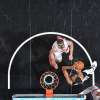A wager on the total points scored from the three-second area (often called the paint or the key) is one of the most logical markets for bettors who read matchups closely and understand how a team manufactures easy twos. This market lends itself well to analysis: rim-attack share, defensive schemes, big-man rotations, and rebounding level all directly shape the final number.
What Exactly Counts as 'Points from the Three-Second Area'
The three-second area is the rectangular zone under the basket where an offensive player may not remain for more than three seconds while his team controls the ball. In the “Points in the Paint” (PITP) stat, only field goals made from this area are counted. Free throws—even if the foul occurred on a drive—are not part of PITP. This matters: some bettors mistakenly add up all “near-rim” points instead of relying on the specific market definition used by the bookmaker and data provider.
How Bookmakers Build the Line
The PITP line typically emerges from several data blocks:
- each team’s average points in the paint (season-long and on shorter samples);
- share of shots at the rim and their accuracy (FG% at Rim);
- number of drives into the paint and the frequency of post-ups/pick-and-rolls;
- pace (possessions per game), which expands overall possession volume;
- opponent quality defending the key: PITP allowed, pick-and-roll coverage (drop/switch/ICE), and second-chance rate.
The more precisely you assemble these pieces and scale them to the expected possession count for the specific game, the closer your projection will be to reality.
Key Game Variables
- Offensive style. Teams that run pick-and-roll with a dominant five or relentlessly attack the rim through drives tend to generate above-average PITP. Groups leaning on perimeter isolations and high three-point volume, by contrast, pull this total downward.
- Big-man rotation and roles. Having an efficient finisher (alley-oops, rolls after screens, high-eFG% post-ups) is a direct argument toward the over. The absence of a center, early foul trouble for the starting five, or a forced small-ball look often triggers an under.
- Defensive schemes. Drop coverage keeps the ball on the perimeter and concedes mid-range—this suppresses the opponent’s PITP. Heavy switching without help from the arc frequently opens lanes to the rim—this boosts PITP. A 2–3 zone can shut the paint yet invite threes.
- Rebounding and second chances. Strong offensive rebounding adds “dirty” twos on put-backs. Teams that concede many offensive boards often nudge the line toward the over by themselves.
- Pace and transition. Run-and-gun teams inflate possession count and early-clock attacks, shortening the path to the rim. Slow, half-court sets reduce volume and usually dry up PITP.
- Officiating and fouls. Early foul trouble for the key big breaks the paint-defense structure. Even though free throws don’t enter PITP, a softened defense due to fouls increases the likelihood of easy twos from the floor.
Quick Algorithm for Preparing a Bet
- Estimate possessions. Multiply the game’s projected pace by both teams’ PITP per possession.
- Adjust for the matchup. Align the offense’s “creation at the rim” (rim-attempt share × rim FG%) with the opponent’s “allowance” in the paint.
- Account for rotations. Injuries/minutes for centers, the starting lineup, possible small-ball.
- Add second chances and transition. Offensive-rebound differential and transition frequency.
- Compare to the line. If your projection yields ≥ 5–8 points of value versus the market (depends on league and variance), the bet is justified.
A handy back-of-the-envelope formula (per team):
Expected PITP = (Rim attempts × expected FG% × 2) + (estimate of put-backs/alley-oops from offensive rebounds × 2).
Where to Find an Edge in Live Betting
- Fouls on bigs in the 1st quarter: an early bench stint for the starting center points to the over.
- Defensive-scheme shifts: moving to a zone to guard the arc lowers PITP; refusing to help off the perimeter raises it.
- Offensive-rebound dominance: if one side controls the opponent’s glass, the PITP market often lags.
- Pace of the first 6–8 minutes: actual possession count can deviate sharply from projections—update your expectations.
Common Mistakes
- Definition confusion. Free throws are not PITP. Verify what your data provider counts and which market the bookmaker is pricing.
- Ignoring garbage time. Blowouts change rotations; PITP can sag late or spike unexpectedly.
- Relying only on season averages. Form and roles change; the last 5–10 games with opponent context often matter more than the raw season mean.
- Skipping opponent style. A team’s high PITP means little if the opponent is elite at sealing the paint.
- Overrating one star. Even a dominant five won’t finish efficiently without perimeter gravity and a clean angle into the roll.
Two Practical Scenarios
Under scenario.
A hypothetical Denver Nuggets vs LA Clippers game. The Clippers’ perimeter load and high three-point volume restrict penetration; for the Nuggets in this specific spot a slower pace is expected (back-to-back/short rotation). Your model outputs a combined 86 PITP while the line is 94.5. An 8–9-point gap supports an under.
Over scenario.
EuroLeague: hypothetical Fenerbahçe vs AS Monaco. Both teams run pick-and-roll often; the hosts have a powerful roller and strong offensive rebounding, while the visitors at times switch without deep help. Your projection is 92 PITP against a market 84.5—an over makes sense.
(Team names illustrate styles; always confirm final decisions with current lineups, pace, and form.)
Long-Term Plan: Turning the Paint into an EV Source
The “points from the three-second area” market reacts to tactics more slowly than full-game totals or spreads. A systematic approach—collecting rim metrics, evaluating defensive schemes, and accounting for rotations and pace—turns guesswork into a repeatable edge. Experiment with modeling: recompute PITP via rim-attempt share and expected accuracy, add adjustments for second chances and transition, and track live signals (fouls/scheme shifts) as the game unfolds. And of course, practice bankroll management: a fixed percentage of bankroll per bet and no chasing losses is the best way to preserve capital and wait for that positive edge.
Bonuses from licensed bookmakers can reduce variance at the start, but read the terms carefully and don’t treat them as guaranteed profit. In the paint, the winner is the one who spots space first—let it be the same with your bets.






